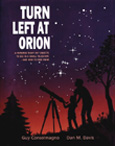
"Turn Left at Orion: A Hundred Night Sky Objects to See in a Small Telescope - and How to Find Them"
Written by Guy Consolmagno and Dan M. Davis.
Illustrations by: Karen Kotash Sepp, Anne Drogin, Mary Lynn Skirvin
Discontinued November 2011, replaced by 4th Ed. Turn Left at Orion: Hundreds of Night Sky Objects To See In A Home Telescope - And How to Find Them
Hardcover - 224 pages, Third Edition November 2000
Cambridge University Press; ISBN: 0521781906
Dimensions: 0.86 x 11.17 x 8.91 inches
Other Available Editions: None
|
This is the book to buy if you now own your first telescope (60mm/2.4 to 80mm/3.1 inch refractor, or up to 15cm/6 inch reflector) or a big binocular, and all you want to read about is how to go out and find objects to see. This book has set a standard of excellence as a guide to helping a beginning astronomer learn how to find their way around the night sky. "Turn Left at Orion" assumes the reader knows nothing about the night sky, and so it is written and nicely illustrated in a manner that will appeal to elementary school children, while still attracting and maintaining the interest of the adult. Unlike many guides to the night sky, this book is specifically written for observers using small telescopes. Clear and easy-to-use, this fascinating book will appeal to sky watchers of all ages and backgrounds. No previous knowledge of astronomy is needed.
This book will help one to understand how the rotation of the Earth and its orbit around the Sun affect what we can find in the night sky from season to season. This book is an aid for someone using a small, reasonable quality telescope who seeks to find the many celestial objects including: double stars, galaxies, nebulae, diffuse nebulae, planetary nebulae, with good information about finding the planets Mercury, Venus, Mars, Jupiter and Saturn in tables updated through to 2011. There is also a well illustrated chapter about how to observe the Moon through its phases. It also has sketches detailing the major planets as they appear in a typical amateur small telescope. A guidebook for beginning amateur astronomers "Turn Left at Orion" also provides all the information you need to locate and begin to observe a whole host of "deep sky" celestial objects - those outside our Solar System including the popular "Messier" catalog. Large format charts and diagrams show the night sky through the seasons, and the faint deep sky objects are illustrated close up and as they may appear in a finderscope and in a good quality small telescope (50 to 70 mm or 2 to 3 inch aperture refractor for example). And for each object there is information on the current state of our astronomical knowledge. All deep sky objects are rated on a scale so that the beginner may better understand which are easier, and which are more challenging to observer. Thoroughly revised and updated in November 2000, this new edition contains a chapter describing spectacular deep sky objects visible from the southern hemisphere, as well as tips on how to observe the upcoming transits of Venus. It also includes a discussion of how to use most amateur beginner telescopes including the Dobsonian telescopes that have come to the forefront of the amateur community as providing the "best bang for the buck". This title also provides hints on using your personal computer and the Internet as aids for planning an observing session. All tables of data have been updated to the year 2011. This book has been favorably reviewed, and is justifiably among the top selling amateur astronomy titles at Company Seven. You may wish to contact Company Seven for a bit more advice about the latest hardware to help one star-hop across the sky (including: a planisphere, a red light flashlight to read the charts at night, and the Telrad sight) after reading the advice in this book. |
Table of Contents:
How to Use This Book ... Page 6 The Moon ... Page 12
When to See Mercury in the Evening Sky, 2000-2011 ... Page 29 Oppositions of Mars, 2001-2012 ... Page 29
Diffuse Nebulae ... Page 51 Planetary Nebulae ... Page 59 Seasonal Objects: Spring ... Page 72
Globular Clusters ... Page 97 Seasonal Objects: Summer ... Page 100
How to Run a Telescope ... Page 202 While you're waiting for the clouds to clear ... Page 202 When you go out to observe ... Page 205 Storing and maintaining the telescope ... Page 207 Computers and the amateur astronomer ... Page 208 Glossary ... Page 212 Tables ... Page 214 Index ... Page 220 Acknowledgments ... Page 224
|
|
|
The Authors: Guy Consolmagno is a Jesuit Brother at the Specola Vaticana (Vatican Observatory). He made contributions using a 3.5 inch aperture Catadioptric telescope. While Dan M. Davis is a Professor of Geophysics in the Department of Earth and Space Sciences at the State University of New York at Stony Brook. His research there concerns the formation of mountain belts on Earth. Most of his observations for this book were done using a 2.5 inch refracting telescope.
Price $25.00 (U.S.D.); please add $4.00 for domestic postage, or $6.00 for international postage.
|
Contents Copyright 1994-2001 Company Seven All Rights Reserved


